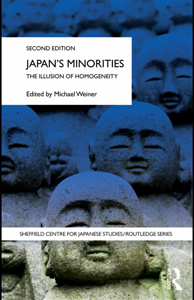Japans Outcaste Youth
Japans Outcaste Youth Education for Liberation
June A. Gordon
First published 2008 by Paradigm Publishers
Published 2016 by Routledge
2 Park Square, Milton Park, Abingdon, Oxon OX14 4RN
711 Third Avenue, New York, NY 10017, USA
Routledge is an imprint of the Taylor & Francis Group, an informa business
Copyright 2008, Taylor & Francis.
All rights reserved. No part of this book may be reprinted or reproduced or utilised in any form or by any electronic, mechanical, or other means, now known or hereafter invented, including photocopying and recording, or in any information storage or retrieval system, without permission in writing from the publishers.
Notice:
Product or corporate names may be trademarks or registered trademarks, and are used only for identification and explanation without intent to infringe.
Library of Congress Cataloging-in-Publication Data
Gordon, June A., 1950
Japans outcaste youth : education for liberation / June A. Gordon.
p. cm.
Includes bibliographical references.
ISBN 978-1-59451-561-3 (hardcover : alk. paper)
1. Buraku peopleJapan. 2. Buraku peopleEducation. 3. DiscriminationJapan. 4. MinoritiesJapanSocial conditions. I. Title.
HT725.J3G67 2008
305.560952dc22
2008006031
Designed and typeset by Straight Creek Bookmakers.
ISBN 13 : 978-1-59451-561-3 (hbk)
ISBN 13 : 978-1-59451-562-0 (pbk)
Contents
This book is dedicated to the late professors John Ogbu and Ikeda Hiroshi whose scholarship and encouragement made this research possible. Their absence is deeply felt. The hundreds of meetings, encounters, and interviews with teachers, community workers, human rights activists, scholars, students, and their families would not have been feasible without access provided by some critical people who have the trust and confidence within Buraku communities. Several Japanese scholars graciously shared their life stories, their struggles, their goals for social justice, their own research and, at times, their homes. In 1996 my first team of professional colleagues included Professor Kanagae Haruhiko of Senshu University, Professor Noguchi Michihiko of Osaka City University, and Professor Nabeshima Yoshiro, all of whom have proven invaluable in guiding my understanding of the nuanced and changing realities of the complex worlds that exist within the Buraku. While other Japanese scholars have worked with me on research pertaining to immigrants and educational reform in Japan, I mention here only those who participated directly in the research for this particular book. However, one scholar who spans both areas and has provided ongoing support is Professor Shimizu Kokichi, my principal colleague during our shared work at Tokyo University and later at Osaka University. Professors Tsukada Mamoru, Fujita Hidenori, Komine Naofumi, Tsuneyoshi Ryoko, and David Willis each added significant support at crucial times. Heartfelt appreciation goes to Mr. and Mrs. Nishino for my many stays and long conversations in their home over the past thirty years and for the numerous translations needed for this book. I owe undying gratitude to Mr. Maruyama Toshio for his belief in the importance of the research and his fortitude to open doors for me that others would not have attempted to crack. My primary thanks, of course, go to the teachers, administrators, and community people who agreed to my interviews and visits. As promised and with a few exceptions, personal names and school names have been changed. In recent years, the encouragement to complete this book has come from friend and colleague, Professor George DeVos, one of the preeminent scholars in the study of minority groups and coauthor of the single most important book on the Burakumin in English. Professor DeVoss partner, Suzanne Lake DeVos, also deserves special mention for her unceasing encouragement. To bring the book to life, I am especially grateful to Professor Nobuo Ken Shimahara who provided a critical reading of the manuscript and to Dean Birkenkamp who has nurtured a publishing ideal that truly supports the independent work of scholars.
The Buraku question is one of the most controversial topics in the study of Japanese culture. Any effort at objective study is beset with the complications of political efforts by, and on behalf of, the Burakumin as a group1 and the divergent views and life choices of individual Burakumin2 as well as widespread agreement among other Japanese citizens to avoid any mention of the topic. My experience as a foreign researcher conducting fieldwork in Japan during the past ten years has shown that discussion of, or research on, issues pertaining to the Burakumin is constrained. Even in academia, those working on Burakumin-related research are subject to the possibility of social ostracization. They can lose friends, jobs, colleagues, spouses, and even their lives in pursuit of understanding the complexity of political, social, economic, and cultural undercurrents unseen to most who so engage. Outside of academia, discussion of the Burakumin belongs to a well-stocked list of taboo subjects in Japanese society.
This book is written from the perspective of my own discovery of the significance of the Buraku mondai (issue) and the political and educational policies and prejudices that have emanated in response to what the Burakumin (people of the village) have over the centuries come to signify to Japanese: contamination and pollution. These views continue to this day and, I argue, are at the foundation of Japans inability to incorporate others, whether they be longstanding resident Korean Japanese, Zainichi, or newly arrived immigrants from China, Southeast Asia, South America, or the Philippines.
I invite the reader to join me as I journey through urban Japan exploring the schools and communities where education is attempted for the children of families who exist at the margins of Japanese society. This first chapter introduces the Burakumin and the context for the effort to bring education to their communities. The second chapter explains the research process and offers vignettes of conversations, observations, interactions, and/or situations that explore the process and the taboos of the research. The third chapter details the historical context for the political movements that led up to the implementation of government policies to alleviate some of the oppressive conditions in which the Burakumin lived. One of the main tools used to carry out such policies was liberation education, Dowa Kyoiku. The remainder of the book shares the voices of educators and community activists through over two hundred interviews as we explore the evolving success and failures of various human rights reform efforts. Throughout the book I have woven commentary and analysis alongside the interviews, hoping that the result draws the reader into the space, the mindset, the immediacy and reality of a situation of which few outsiders seem to be aware.
Burakumin has become the accepted term for persons legally designated during the Tokugawa period (16031867) as eta (impure), persons who were placed outside of the four-tiered traditional hierarchy of samurai (warriors), farmers, artisans, and merchants that had developed over hundreds of years in the settling of Japan.3 Performing essential tasks for the functioning of village life as guards, processors of meat and leather products, grave diggers, shrine janitors, sandal makers, and prison workers, the










